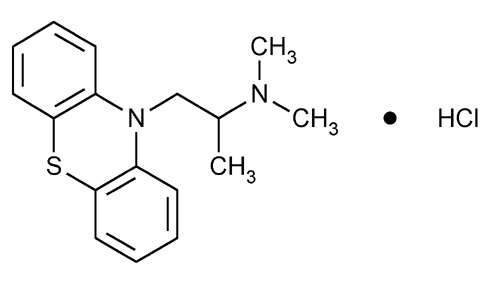Promethazine Hydrochloride
10H-Phenothiazine-10-ethanamine, N,N,
(±)-10-[2-(Dimethylamino)propyl]phenothiazine monohydrochloride
» Promethazine Hydrochloride contains not less than 97.0 percent and not more than 101.5 percent of C17H20N2S·HCl, calculated on the dried basis.
Packaging and storage—
Preserve in tight, light-resistant containers.
Completeness and clarity of solution—
Separately prepare a 1 in 10 solution of it in water and 1 in 10 solution of it in chloroform: each solution is practically clear and shows not more than a light yellow color.
note—Throughout the following procedures, protect test or assay specimens, the Reference Standard, and solutions containing them, by conducting the procedures without delay, under subdued light, or using low-actinic glassware.
pH  791
791 :
between 4.0 and 5.0, in a solution (1 in 20).
:
between 4.0 and 5.0, in a solution (1 in 20).
Loss on drying  731
731 —
Dry it at 105
—
Dry it at 105 for 4 hours: it loses not more than 0.5% of its weight.
for 4 hours: it loses not more than 0.5% of its weight.
Residue on ignition  281
281 :
not more than 0.1%.
:
not more than 0.1%.
Related substances—
Standard preparation
and Standard dilutions—Dissolve an accurately weighed quantity of USP Promethazine Hydrochloride RS in methylene chloride to obtain a solution containing 10.0 mg per mL (Standard preparation). Prepare a series of quantitative dilutions of the Standard preparation in methylene chloride to contain 0.2, 0.1, 0.05, and 0.025 mg per mL (Standard dilutions) corresponding to 2.0%, 1.0%, 0.5%, and 0.25% of impurities, respectively.
Test solution—
Dissolve 100 mg, accurately weighed, of Promethazine Hydrochloride in 10.0 mL of methylene chloride.
Procedure—
Using a 20- × 20-cm thin-layer chromatographic plate (see Chromatography  621
621 ) coated with a 0.25-mm layer of silica gel mixture, apply 10-µL portions of the Test preparation, the Standard preparation, and each of the Standard dilutions 2.5 cm from the lower edge of the plate. Develop the plate in an unsaturated tank containing a mixture of ethyl acetate, acetone, alcohol, and ammonium hydroxide (90:45:2:1). After the solvent has moved not less than 10 cm, air-dry the plate, and view under short-wavelength UV light: the RF value of the principal spot obtained from the Test preparation corresponds to that from the Standard preparation. Estimate the concentration of any other spots observed in the lane for the Test preparation by comparison with the Standard dilutions: the sum of the impurities is not greater than 2.0%, and no single impurity is greater than 1.0%.
) coated with a 0.25-mm layer of silica gel mixture, apply 10-µL portions of the Test preparation, the Standard preparation, and each of the Standard dilutions 2.5 cm from the lower edge of the plate. Develop the plate in an unsaturated tank containing a mixture of ethyl acetate, acetone, alcohol, and ammonium hydroxide (90:45:2:1). After the solvent has moved not less than 10 cm, air-dry the plate, and view under short-wavelength UV light: the RF value of the principal spot obtained from the Test preparation corresponds to that from the Standard preparation. Estimate the concentration of any other spots observed in the lane for the Test preparation by comparison with the Standard dilutions: the sum of the impurities is not greater than 2.0%, and no single impurity is greater than 1.0%.
Assay—
Dissolve about 700 mg of Promethazine Hydrochloride, accurately weighed, in a mixture of 75 mL of glacial acetic acid and 10 mL of mercuric acetate TS. Add 1 drop of crystal violet TS, and titrate with 0.1 N perchloric acid VS to a blue endpoint. Perform a blank determination, and make any necessary correction. Each mL of 0.1 N perchloric acid is equivalent to 32.09 mg of C17H20N2S·HCl.
Auxiliary Information—
Please check for your question in the FAQs before contacting USP.
Chromatographic Column—
| Topic/Question | Contact | Expert Committee |
| Monograph | Daniel K. Bempong, Ph.D.
Senior Scientist 1-301-816-8143 |
(MDPS05) Monograph Development-Pulmonary and Steroids |
| Reference Standards | Lili Wang, Technical Services Scientist 1-301-816-8129 RSTech@usp.org |
USP32–NF27 Page 3405
Pharmacopeial Forum: Volume No. 32(4) Page 1105
Chromatographic columns text is not derived from, and not part of, USP 32 or NF 27.
